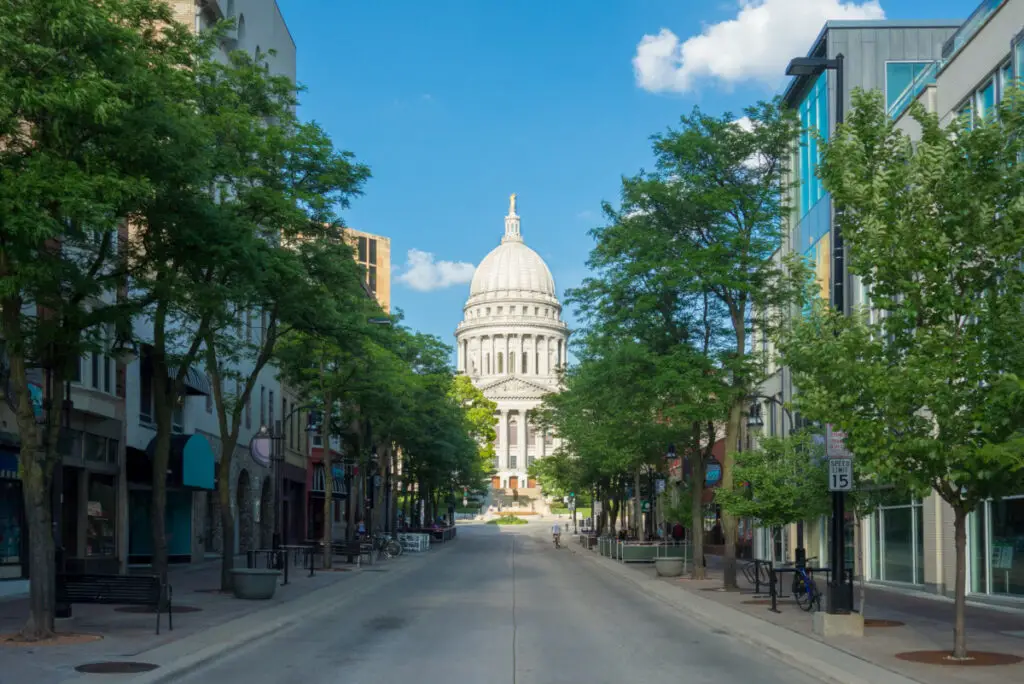
Politics are the source of a lot of controversies these days, and many people want those around them to have similar political beliefs to their own. If you live in Madison, Wisconsin, are your neighbors more likely to be liberal or conservative?
Madison, Wisconsin is a very liberal city. The majority of residents in the city voted for the Democratic candidates in every election since 2000. Dane County, Madison’s county, is also a very liberal area, while Wisconsin is a swing state that leans liberal.
There are many factors to the political climate of a city. It is important to look at the results of presidential elections, the local leaders, the supported policies, and the demographics of Madison before figuring out if it is liberal or conservative.
Presidential Elections
The results of presidential elections in a city are a big indicator of the political climate. The two major political parties in the United States, the Democratic party and the Republican party, represent the liberal and conservative perspectives. The Democratic party has mostly liberal members and supports liberal policies, while the Republican party has mostly conservative members and supports conservative policies. If the majority of residents in a city voted for the Democratic candidate, the city is mostly liberal, but if the majority voted for the Republican candidate, the city is mostly conservative.
It is important to consider not only which candidate got the most votes, but also by how many votes they won. In every election, a certain percentage of the vote is for the Democratic candidate, and another percentage is for the Republican candidate. The difference between these percentages is the amount that the winning candidate won by. If this difference is high, they won by a large amount, and the city is solidly liberal or conservative. If the difference is low, the city is closer to being evenly split between liberal and conservative.
Wisconsin is a swing state. Most states can be counted on to vote either Democratic or Republican, but swing states can go either way. Though they tend to lean Democratic or Republican, the percentages are close, and it wouldn’t take much to tip the vote the other way.
Wisconsin leans liberal . The majority of residents voted for the Democratic candidate in five of the last six elections, with the Republican candidate winning over the state in 2016. The difference between the percentage of Democratic and Republican votes was lower than 1% in every election except for the 2008 and 2012 elections. The highest difference was 13.9% in 2008, and the lowest difference was 0.2% in 2000.
. The majority of residents voted for the Democratic candidate in five of the last six elections, with the Republican candidate winning over the state in 2016. The difference between the percentage of Democratic and Republican votes was lower than 1% in every election except for the 2008 and 2012 elections. The highest difference was 13.9% in 2008, and the lowest difference was 0.2% in 2000.
In the 2020 presidential election, 49.5% of Wisconsin residents voted for the Democratic candidate, while 48.8% voted for the Republican candidate. The difference was 0.7%, which was the third lowest after 2000 and 2004, tied with 2016.
Dane County, the county in which Madison is, is a very liberal area . The majority of city residents voted for the Democratic candidate in every presidential election since 2000. The difference between the percentages was between 25% and 55% in every election during that time. The lowest difference was 28.59% in 2000, and the highest was 52.6% in 2020.
. The majority of city residents voted for the Democratic candidate in every presidential election since 2000. The difference between the percentages was between 25% and 55% in every election during that time. The lowest difference was 28.59% in 2000, and the highest was 52.6% in 2020.
In the 2020 election, 75.46% of Dane County residents voted for the Democratic candidate, while 22.86% voted for the Republican candidate. The difference was 52.6%, which is the highest it was during that 20-year period.
The city of Madison, like its county, is a very liberal city . The Democratic candidate got the most votes in the city in every election this century. The difference between the percentages of Democratic and Republican votes was higher than 10% in every election during that time.
. The Democratic candidate got the most votes in the city in every election this century. The difference between the percentages of Democratic and Republican votes was higher than 10% in every election during that time.
From 2018 to 2021, there were 102,068 contributions to the Democratic party in Madison. These contributions came to a total of $12,522,344. In contrast, there were only 7,138 contributions to the Republican party in Madison during that same time frame. Those contributions added up to $2,338,183. The donations to the Republican party were about 2.5 times larger on average than those to the Democratic party.
Local Leaders

The local leaders of a city represent the political climate. The local leaders are elected by the people based on their beliefs and promises. We need to look at the enacted policies, campaign platforms, and party affiliations of the local leaders of Madison to more accurately gauge the political climate.
Mayor
The mayor of Madison is one of the most important elected officials in the city. The mayor represents the city in state, national, and international matters. The mayor also proposes a budget, signs legislation, appoints directors, and oversees the operations of the city.
The current mayor is Satya Rhodes-Conway . She was elected in 2019 and will serve until 2023. She won the general election with 61.9% of the vote, winning by 18,765 votes.
. She was elected in 2019 and will serve until 2023. She won the general election with 61.9% of the vote, winning by 18,765 votes.
Mayor Rhodes-Conway is the second female mayor and the first LGBTQ+ mayor. She served for 3 terms on the city council starting in 2007.
Mayor Rhodes-Conway’s focuses in office have been on increasing affordable housing, improving the public transit system, implementing sustainable policies, and supporting those in mental health crises.
Mayor Rhodes-Conway is affiliated with the Democratic party. Her initiatives and focuses in office have supported the idea that she is of a liberal perspective.
Common Council
The Madison Common Council is a board of elected officials that serves as the primary legislative body of the city. The council is responsible for approving the city budget. The council is made up of 20 alders. Each alder is elected by one of the city’s 20 districts and serves for two years.
is a board of elected officials that serves as the primary legislative body of the city. The council is responsible for approving the city budget. The council is made up of 20 alders. Each alder is elected by one of the city’s 20 districts and serves for two years.
All of the current alders are considered nonpartisan. However, the goals and initiatives of the city council suggest that the majority of the council is made up of liberal alders.
Policies
The policies supported in a city are another indicator of the political climate. There are certain policies that are more likely to be supported or opposed by liberals or conservatives. Fewer abortion restrictions, more gun control laws, and legal same-sex marriage are all policies that are likely to be supported by liberals and opposed by conservatives.
Abortions
Abortions must be performed before a patient is 20 weeks pregnant unless their life is in danger. Patients must receive state-directed counseling and an ultrasound at least 24 hours before an abortion can be provided. Health plans, public funding, and insurance policies for public employees cannot cover abortions except in cases of life endangerment, rape, or incest. The parents of a minor must consent before that minor can receive an abortion.
pregnant unless their life is in danger. Patients must receive state-directed counseling and an ultrasound at least 24 hours before an abortion can be provided. Health plans, public funding, and insurance policies for public employees cannot cover abortions except in cases of life endangerment, rape, or incest. The parents of a minor must consent before that minor can receive an abortion.
In 2017, there were 6 facilities in Wisconsin that provide abortions, 3 of which were clinics. This is a 25% decrease from 2014. 97% of Wisconsin counties don’t have abortion clinics, leaving 70% of women without access to abortions.
Madison citizens tend to support a decrease in abortion restrictions and an increase in abortion clinics, which is consistent with a liberal perspective.
Gun Control Laws
In 2020, Wisconsin had the 15th lowest gun death rate and 16th highest crime gun export rate in the country. Wisconsin gun laws include domestic violence gun laws, child access prevention laws, state database background checks for handguns, and handgun dealer regulations. Wisconsin gun laws do not include universal background checks, gun owner licensing, assault weapon or large capacity magazine restrictions, waiting periods, or concealed or open carry regulations.
domestic violence gun laws, child access prevention laws, state database background checks for handguns, and handgun dealer regulations. Wisconsin gun laws do not include universal background checks, gun owner licensing, assault weapon or large capacity magazine restrictions, waiting periods, or concealed or open carry regulations.
Madison residents tend to support an increase in gun control laws, which is consistent with a liberal perspective.
Same-Sex Marriage
Wisconsin legalized same-sex marriage on October 6, 2014 , and was the 20th state to do so, tied with Indiana, Oklahoma, Utah, and Virginia. This was about 8 months before the Supreme Court mandate was passed requiring all states to legalize same-sex marriage. Madison residents generally supported the legalization of same-sex marriage.
, and was the 20th state to do so, tied with Indiana, Oklahoma, Utah, and Virginia. This was about 8 months before the Supreme Court mandate was passed requiring all states to legalize same-sex marriage. Madison residents generally supported the legalization of same-sex marriage.
Demographics

The population of Madison is about 263,094 people. The population density is 3,338 people per square mile. 50.6% of the population is female, and 49.4% is male. The median age is 30.8, and the average number of people per household is 2.2.
of Madison is about 263,094 people. The population density is 3,338 people per square mile. 50.6% of the population is female, and 49.4% is male. The median age is 30.8, and the average number of people per household is 2.2.
The racial makeup of Madison is as follows:
of Madison is as follows:
- White: 74.5%
- Black: 6.4%
- Hispanic/Latino: 7.0%
- Asian: 8.7%
- Native American: 0.3%
- Hawaiian/Pacific Islander: 0.0%
- Two or More Races: 3.0%
- Other: 0.1%
The average income in Madison is $31,659 per year. The median household income is $53,933 per year. The unemployment rate is 3.3%. The sales tax rate is 5.5%, and the income tax rate is 6.3%.
in Madison is $31,659 per year. The median household income is $53,933 per year. The unemployment rate is 3.3%. The sales tax rate is 5.5%, and the income tax rate is 6.3%.
95.4% of Madison residents are high school graduates, and 15.8% are only high school graduates. 32.2% have two-year degrees, 57.1% have four-year degrees, 4.4% have master’s degrees, and 5.1% have professional degrees.
of Madison residents are high school graduates, and 15.8% are only high school graduates. 32.2% have two-year degrees, 57.1% have four-year degrees, 4.4% have master’s degrees, and 5.1% have professional degrees.
46.9% of Madison residents are religious. 44.9% are Christian, 0.6% are Jewish, 0.4% are of an eastern faith, and 0.5% are affiliated with Islam.
of Madison residents are religious. 44.9% are Christian, 0.6% are Jewish, 0.4% are of an eastern faith, and 0.5% are affiliated with Islam.
The rate of violent crime in Madison on a scale of 1 to 100 is 16.7. The rate of property crime on the same scale is 41.6. The rate of violent crime is lower than the national average, but the rate of property crime is higher than the national average.
in Madison on a scale of 1 to 100 is 16.7. The rate of property crime on the same scale is 41.6. The rate of violent crime is lower than the national average, but the rate of property crime is higher than the national average.
